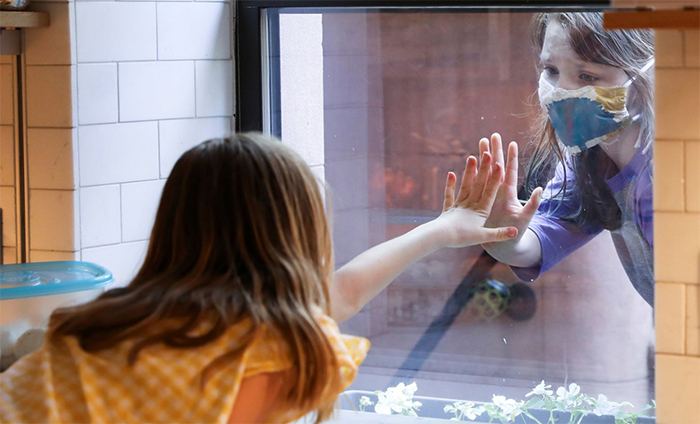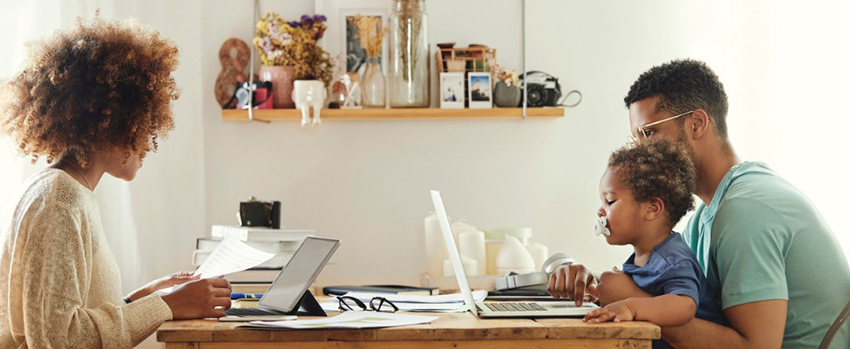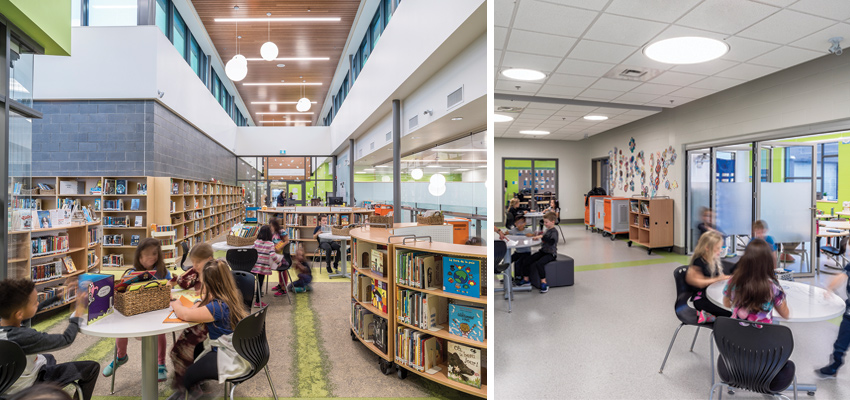
By Christina Legris, Partner, Education + Recreation Studio Lead
 It is hard not think about the dramatic impact that a rapidly spreading global pandemic will have on our psyche and our perception of the spaces that we occupy everyday. What will our world look like? What will it take for us to be able to trust our surroundings in a way that allows us to gather and connect as a community? By nature, humans are social beings, and now more than ever we crave a connection with others that can not be fulfilled completely by on-line social platforms.
It is hard not think about the dramatic impact that a rapidly spreading global pandemic will have on our psyche and our perception of the spaces that we occupy everyday. What will our world look like? What will it take for us to be able to trust our surroundings in a way that allows us to gather and connect as a community? By nature, humans are social beings, and now more than ever we crave a connection with others that can not be fulfilled completely by on-line social platforms.
While technology has allowed for innovative and creative solutions as we attempt to maintain the status quo, the truth for many is that it just does not feel right. The nuances of facial expressions and eye contact, body language and physical chemistry cannot be matched. This is even more true for children. Creating a sense of community in learning environments promotes the development of fundamental skills in children such as citizenship, responsibility, and empathy.

I have observed the impact of isolation in my own children as we navigate this separation from friends and family. Their need for physical and emotional closeness has intensified during these times. In our home/work environment, while we attempt to create separate workspaces throughout the house so that each of us have our own privacy and focus space, by the end of the day we are all at the same table, inches away from each other.
Modern school design aims to enhance the social experience, encourage collaboration, and create opportunities for students to engage and gather while providing the flexibility to support a variety of teaching styles. Modern classrooms are set up with flexible, moveable furniture arrangements that allow students to work closely and collaboratively, promoting the sharing of ideas and encouraging diverse thinking.
So, what now? How do we maintain this sense community and social connection in our learning environments post COVID-19 (and post-post-COVID-19) when our natural tendencies for human interaction and connection have been restricted? How do our children learn the fundamentals of socialization and human interaction when what we need to do to keep them safe, is to keep them apart? Once the dust settles and fears subside, what will be the impacts on our psyche, for children whose development and learning are dramatically impacted by social connections? Do we go back to the ‘cells and bells’ of traditional school design, or is the flexibility, openness and focus on emotional and physical health of 21st century schools important now more than ever ?
 21st Century Learning at École Sage Creek School, Winnipeg, MB
21st Century Learning at École Sage Creek School, Winnipeg, MB
The design of innovative learning environments encourages a holistic approach to student well-being, providing spaces that promote flexible and varied teaching methods, similar to what we are now seeing in our living rooms, bedrooms and at dining room tables.
It will be expected that as our children return to the classroom, things will be different. Hand sanitizer stations, plexiglass protective shields and face masks will likely start appearing in schools - important to provide some level of comfort for parents and teachers as we transition back into a more “normal” world. Does this need to be the new long-term reality, or are there ways that the design of our buildings and schools can allow us to feel safe, without feeling scared and isolated from each other?
After the tragic shootings at Columbine and Sandy Hook in the United States, metal detectors and bullet proof glass became common at the entries of schools across the country. The reaction was to isolate and protect - to batten down the hatches and keep children safely out of reach from intruders. This meant internalizing schools from the outdoors and the surrounding community. Windows got smaller and entries were hidden. Schools became fortresses.
The psychological impact of this isolation on students and teachers was notable. Buildings designed for the worst, inspired feelings of fear and anxiety, which can breed distrust, insecurity, and unrest. This goes against our natural tendencies for human interaction and connection. In reaction to this, the pendulum swung once again, and the approach to school design started to focus on transparency and connectivity - creating a feeling of safety and security through a connection to others. This was an "eyes on the street" approach, where protection is found in the collective
A viral pandemic like COVID-19 will likely have a different impact on our physical environment because of the unpredictable nature of the spread, but if we are not careful, the psychological impacts may very well be the same. Good school design will be vital in our response.
Looking forward to a ‘new reality’ post COVID-19, there are several ways that our schools can adapt to create a safe and healthy environment, using the current 21st Century Learning “toolbox” of design principles:
![]() Welcoming and Safe Entry: recently used as a security measure on schools, the orientation of the entry vestibule to the school administration and reception creates a means to stop visitors from entering the school without first circulating through the reception area. Transparency between reception and the vestibule allow staff to see who is entering the school before they are permitted to enter and ensure that sanitizing protocols are followed. A transaction window is a simple way to maintain this transparency and connection while creating a physical barrier between reception and visitors.
Welcoming and Safe Entry: recently used as a security measure on schools, the orientation of the entry vestibule to the school administration and reception creates a means to stop visitors from entering the school without first circulating through the reception area. Transparency between reception and the vestibule allow staff to see who is entering the school before they are permitted to enter and ensure that sanitizing protocols are followed. A transaction window is a simple way to maintain this transparency and connection while creating a physical barrier between reception and visitors.![]()
Flexible instructional spaces: reconfigure flex spaces to accommodate smaller teaching groups, reducing the number of students in classrooms. Using every other desk may cut your capacity in half or more. Making use of breakout spaces, Learning Commons and Project rooms or learning labs as dedicated seating areas can increase the capacity for students while maintaining physical distancing.
![]()
Learning Communities: learning communities scale down large student populations and provide a more ‘home- like’ environment for students, creating a stronger sense of belonging and connection to peers within similar age groups; classrooms are set up with flexible, moveable furniture arrangements with allows students the ability work collaboratively, promoting the sharing of ideas and diverse thinking.![]()
![]() Fresh air, natural ventilation, and daylight: a fundamental principle in 21st Century learning environments as access to daylight and views to the outdoors is proven to improve overall health and well-being of students and teachers. Creating opportunities for visual relief allows the brain to take breaks from focused tasks and screen time, connecting us to our natural surroundings. Outdoor Learning Environments such as outdoor classrooms, rooftop gardens and patios as well as active learning landscapes can all provide opportunities for flexible instruction that allows for greater physical distancing in in an open-air environment.
Fresh air, natural ventilation, and daylight: a fundamental principle in 21st Century learning environments as access to daylight and views to the outdoors is proven to improve overall health and well-being of students and teachers. Creating opportunities for visual relief allows the brain to take breaks from focused tasks and screen time, connecting us to our natural surroundings. Outdoor Learning Environments such as outdoor classrooms, rooftop gardens and patios as well as active learning landscapes can all provide opportunities for flexible instruction that allows for greater physical distancing in in an open-air environment.
It is not a new concept to use access to daylight and the outdoors as an important response to a global health crisis. Early in the 20th century with the rampant spread of diseases such as tuberculosis and the Spanish flu, medical facilities were designed to provide patients access to sunlight and fresh air, the only known treatment for the disease. This inspired architects to use similar concepts and ideas to promote mental and physical health in new building designs. Additional reading: Crisis Helped Shape Modern Architecture
![]()
HVAC and humidity control: Radiant floor heating and cooling systems, as well as displacement ventilation can provide a cleaner approach to heating, ventilation, and cooling systems. Both systems take advantage of the natural buoyancy of air, creating convection air currents within a space. This provides a more comfortable thermal environment for users and reduces the spread of pollutants through a forced air system which circulates air throughout a building.
Controlling the humidity in buildings is also critical in reducing the spread of bacteria and pathogens. Low humidity is optimal for the long distance spread of airborne particles. Maintaining an optimum level of humidity through and integrated humidity control system can help ensure user comfort and safety.
So much of how we learn relies on the experiences that happen in between the formal lessons. Learning truly is everywhere and some of the richest lessons come from our relationships and interactions with our peers and leaders. The ability to adapt our learning environments today and for future events, will be key to keeping our students and teachers comfortable and safe, while maintaining the core principals of modern pedagogy and the essence of the human experience.
Christina is a Partner at Number TEN Architectural Group

